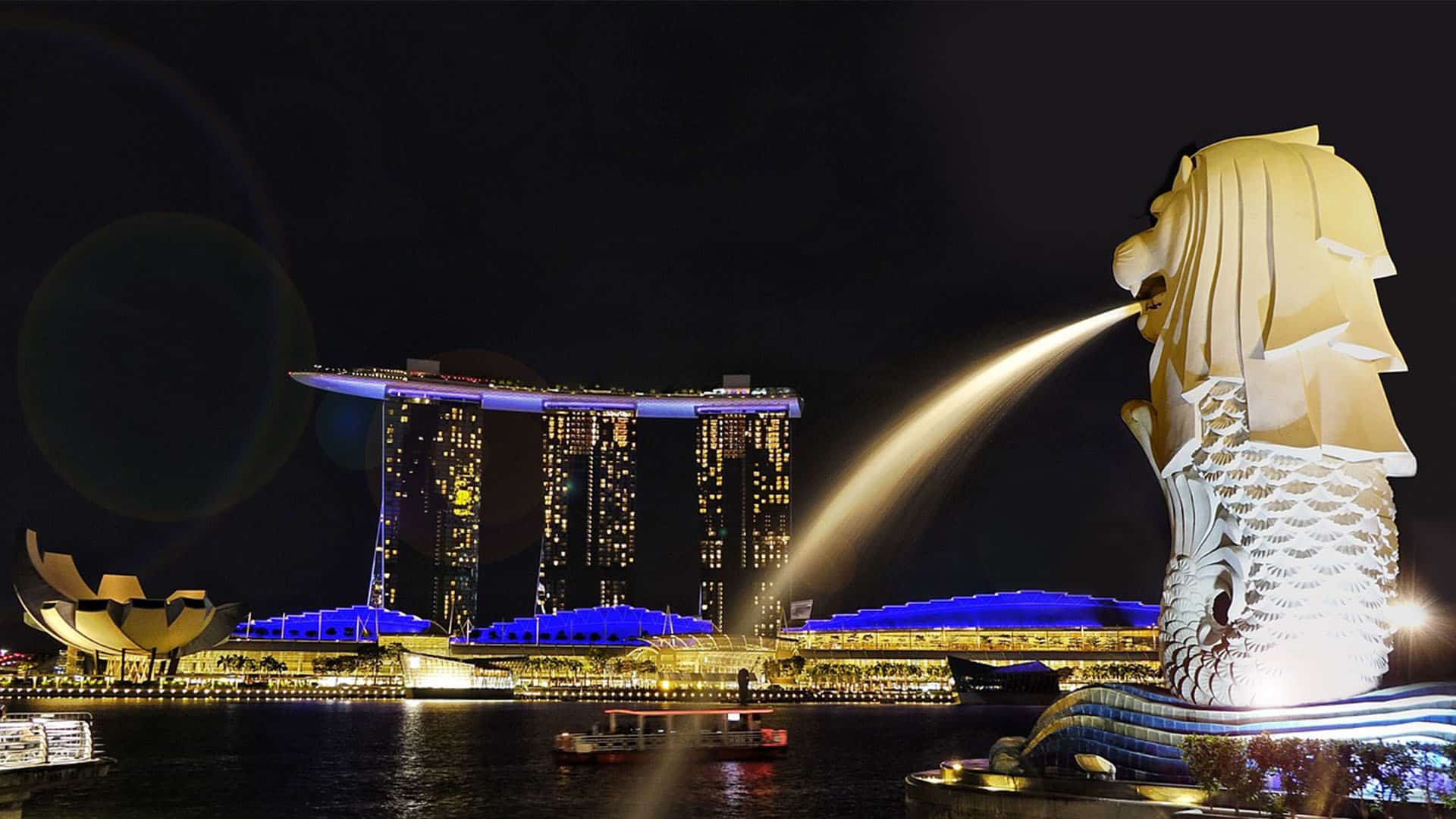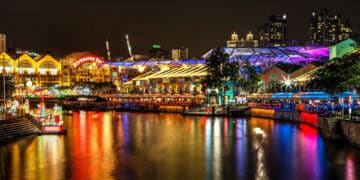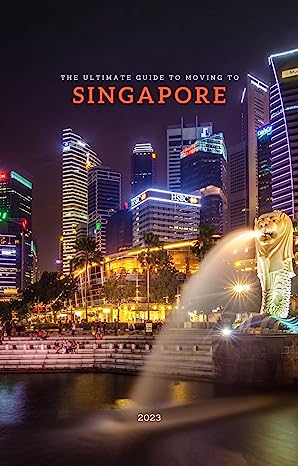The Merlion is an enduring symbol of Singapore, seamlessly blending myth with modernity. Situated at Merlion Park, near the Central Business District (CBD) at One Fullerton, this iconic statue boasts a commanding view of the Marina Bay waterfront. The statue, featuring the head of a lion and the body of a fish, encapsulates Singapore’s humble beginnings as a fishing village and its original name, Singapura, meaning ‘lion city’. Today, Merlion Park provides visitors with not only a piece of Singapore’s rich history but also a picturesque vista that beautifully marries the city’s skyline with its cultural heritage.
Merlion Park, which features the prominent Merlion statue, is a major tourist attraction and a vital emblem for the people of Singapore. The park’s central location near key landmarks and its accessibility through various modes of transportation make it a convenient stop for tourists exploring the city. Beyond the Merlion, visitors can also enjoy a variety of statues and artistic representations that celebrate the narrative of Singapore, contributing to a comprehensive visitor experience that balances educational aspects with leisure.
Key Takeaways
- The Merlion, an iconic symbol of Singapore, stands prominently at Merlion Park.
- Merlion Park, located at One Fullerton near Singapore’s CBD, is easily accessible to visitors.
- The park offers a blend of cultural heritage and scenic views, augmenting the tourist experience.
The Merlion of Singapore
The Merlion, Singapore’s esteemed national icon, stands as a testament to the city’s rich history and symbolic representation. Visitors and locals alike recognize this majestic statue as an embodiment of Singapore’s past and present.
Historical Significance
The Merlion’s history is a compelling narrative of national identity and branding. Inaugurated in 1972, it was created as a mascot for the Singapore Tourism Board, symbolizing the city’s humble beginnings as a fishing village known as Temasek, or ‘sea town’. Its name and figure also draw on the legend of Sang Nila Utama, who saw a lion on the island, which inspired the naming of the city as Singapura, or ‘lion city’.
Design and Symbolism
The design of the Merlion combines a lion’s head with the body of a fish, encapsulating Singapore’s original identity linked to the sea and its ancient name. The lion represents Singapore’s original name Singapura — ‘lion city’ — while the fish tail symbolizes the island’s origins as a fishing village. This blend of elements reflects the nation’s aspirations and journey from a simple past to its modern, cosmopolitan status.
Location and Accessibility
The primary Merlion statute is located at Merlion Park, near One Fullerton at the Marina Bay waterfront, easily accessible and prominently situated within the Central Business District. Its address is a focal point for visitors:
- Address: Merlion Park, One Fullerton, Singapore
Visitors can reach the site within a 5-minute walk from Raffles Place MRT station. The park is open to the public and within walking distance of notable landmarks like The Fullerton Hotel, offering ease of access for those who wish to witness this national personification face-to-face.
Merlion Park and Marina Bay
Located within the central business district of Singapore, Merlion Park is a symbol of Singapore’s heritage as both a garden city and a global port. It provides visitors with picturesque views of Marina Bay, complemented by heritage-rich landmarks and modern architectural marvels.
Nearby Attractions
- Marina Bay Sands: A renowned integrated resort, featuring a hotel, casino, museum, and an observation deck.
- Gardens by the Bay: Famous for its futuristic SuperTree Grove and large climate-controlled biodomes.
- Fullerton Hotel: A luxury hotel that was once the General Post Office, situated near the park.
- Esplanade Bridge and Marina Centre: These landmarks offer a mix of cultural entertainment and shopping experiences within walking distance of the park.
Panoramic Views
- City Skyline: Merlion Park offers a vantage point for Singapore’s dazzling skyline, including the iconic Marina Bay Sands and Raffles Place.
- Singapore River: This historic river leads up to Marina Bay, and the park offers a spot to observe boats gliding past.
- Marina Bay Waterfront: The waterfront area is perfect for sightseeing and capturing memorable photos of the city’s mix of traditional and modern architecture.
Visiting Merlion Park
- Tourism and Culture: Visitors often come to Merlion Park to engage with Singaporean culture, pick up souvenirs, and learn more about local mythology.
- Sightseeing: Ideal for both daytime explorations and nighttime views when the cityscape lights up.
- Getting There: Easily accessible via public transport, with Raffles Place MRT station being the nearest stop.
Statues and Art in Singapore
Singapore’s landscape offers an array of public art, ranging from statues that bear historical significance to contemporary art installations that reflect the city’s modern ethos.
Merlion Statues Across Singapore
The Merlion, conceptualized by Alec Fraser-Brunner for the Van Kleef Aquarium, stands as an emblematic representation of Singapore. Sculpted by Lim Nang Seng, the original Merlion statue was officially installed on September 15, 1972, by then-Prime Minister Lee Kuan Yew. This mythical creature combines a lion’s head, symbolizing the folkloric discovery of Singapore as a lion city, with the tail of a fish, acknowledging Singapore’s origins as a fishing village.
- Primary Location: Merlion Park, near the Central Business District.
- Height: The main statue is 8.6 meters tall.
- Companion Piece: A smaller Merlion statue, known as the Merlion cub, is situated nearby.
Art Installations and Exhibits
Singapore’s vibrant art scene is punctuated by its numerous installations and exhibits that are curated by events such as the Singapore Biennale. Contemporary artists like Tatzu Nishi have engaged with the city by transforming public spaces into thought-provoking environments. Additionally, the Singapore Tourism Board encourages the proliferation of public art, making renowned sculptures an integral part of Singapore’s skyline, thus ensuring art remains accessible to the city’s residents and visitors alike.
- Noteworthy Exhibits: Art exhibitions are frequently held across diverse venues, blending historical themes with innovative artistry.
- Public Accessibility: A primary goal for the city’s art initiatives, with sculptures and art installations placed in open spaces for public enjoyment.
Tourism and Visitor Experience
Merlion Park, as a centerpiece of Singapore tourism, offers visitors a blend of cultural heritage and modern entertainment. It draws countless tourists who seek to engage with the city’s iconic symbol while enjoying the picturesque surroundings of Marina Bay.
Activities and Events
Visitors to Merlion Park can enjoy a range of activities. Daytime offers perfect opportunities for photography, with the Merlion statue providing a majestic backdrop. Tourists can partake in guided tours, which are sometimes hosted by the Singapore Tourism Board to enrich the visitor experience with historical insights and cultural anecdotes. The park is also a hub for occasional cultural events and celebrations that showcase Singapore’s vibrant heritage.
Dining and Shopping
For those looking to dine, Merlion Park is surrounded by a variety of cafes and eateries that provide an array of culinary options. From casual bites to upscale dining, there is something to suit every palate, often with the added bonus of enjoying a view of the city’s skyline during both day and night time.
A short stroll from the park leads visitors into a dynamic shopping atmosphere, where many nearby malls and shops offer everything from luxury brands to unique souvenirs. The close proximity to Singapore’s Central Business District means that there’s a seamless blend of leisure and retail therapy available, ensuring an experience that caters to the diverse interests of tourists.
Preservation and Legacy
The Merlion’s progressive preservation and integration into Singaporean culture exemplify the nation’s commitment to heritage and identity. These efforts mark a balance between maintenance and cultural representation.
Maintenance and Restoration
The Merlion statue has undergone various maintenance and restoration works to ensure its longevity as a national icon. Notably, it was relocated in 2002 from the mouth of the Singapore River to prevent it from obstructing the bridge’s construction. This delicate operation involved lifting the statue with a crane. Post-relocation, the Merlion continued to serve as a beacon of Singapore’s history, from its early days as a fishing village to its modern skyline.
Further enhancing its structural integrity, lightning protection systems and periodic restorations are implemented to safeguard the statue against natural wear and tear. These restoration efforts reflect not only an aspiration to preserve the Merlion’s physical form but also its symbolic stature in Singapore.
Merlion in Singaporean Culture
The Merlion is deeply woven into the cultural tapestry of Singapore. As a mascot and emblem, it draws from both Malay and Sanskrit influences; “Singapura” — from the Sanskrit for “lion city” — encapsulates Singapore’s origin story. The fish body represents Singapore’s beginnings as a fishing village, while the lion head pays homage to its name’s origin.
First introduced as a logo for the Singapore Tourism Board, this chimera was trademarked in 1966, marking the start of its journey as Singapore’s emblem and mascot. Positioned near Raffles Place Station, it is easily accessible, reminding Singaporeans and tourists alike of the city-state’s rich heritage.
The Merlion is not only a statue; it is a celebratory figure in literature and local festivities. Poet Edwin Thumboo and other literary figures have referenced the Merlion, infusing it with layers of meaning. Celebrations, such as the statue’s 50th anniversary, underscore its auspicious role in the country’s narrative, from Ang Mo Kio to Chinatown, and from the Singapore River to Sentosa Island. Its image adorns various memorabilia, reinforcing its status as a cherished emblem throughout Singapore.
Connectivity and Transportation
Transportation to Merlion Park, the iconic symbol of Singapore, is well-facilitated by an extensive network of public transport. Visitors can easily reach the landmark by bus or MRT, making it accessible from various points across the city.
Access Routes to Merlion Park
By MRT:
The closest MRT station to Merlion Park is Raffles Place Station, which is connected to both the East West Line and the North South Line. Upon exiting, one can walk through the business district to reach the park. It takes approximately five minutes to reach Merlion Park on foot from Raffles Place Station.
By Bus:
Several bus services run close to Merlion Park, including:
- Bus: 10, 100, 107, 57, 75
These buses have designated stops near the park, from which visitors can disembark and take a short walk to their destination.
Navigating the Surrounding Area
Merlion Park is situated in the Marina Bay area, surrounded by key attractions within walking distance. Key landmarks include:
- Marina Bay Sands Hotel – A distinct part of the Singapore skyline, known for its unique architecture and luxury amenities.
- Gardens by the Bay – A futuristic park with giant tree-like structures offering spectacular views and garden exhibits.
- Helix Bridge – An architecturally stunning pedestrian bridge leading to Marina Bay Sands and offering splendid views of the city.
- Singapore Flyer – One of the world’s largest observation wheels, offering panoramic views of Marina Bay and beyond.
These attractions are connected by the Esplanade Bridge and the promenade at Marina Centre, facilitating easy and enjoyable circuits around the area.
Where Is The Merlion In Singapore Located? – Frequently Asked Questions
The subsections below address some common inquiries regarding the Merlion, its history, accessibility, locations, and the experiences it offers to visitors in Singapore.
What is the significance of the Merlion to Singapore?
The Merlion is a symbolic representation of Singapore’s origins as a fishing village and its original name, Singapura, which means “Lion City.” The creature’s lion head denotes the folklore of Prince Sang Nila Utama’s discovery of a lion on Temasek, leading to the renaming of the island as Singapura.
Can visitors enter the inside of the Merlion structure?
Visitors could enter the larger Merlion statue on Sentosa Island before it was demolished in 2020, where an observation deck offered a panoramic view of the surroundings. However, visitors cannot enter the Merlion statue at Merlion Park in Marina Bay.
What is the history behind the creation of the Merlion?
The Merlion was designed by Kwan Sai Kheong and built by local craftsman Lim Nang Seng. It was first unveiled on September 15, 1972, as a symbol for the Singapore Tourism Board and has since become a national icon.
In which locations can one find the six Merlion statues in Singapore?
There are six recognized Merlion statues in Singapore: two at Merlion Park, one at Tourism Court, one on Mount Faber, one at Sentosa Island, and one in Ang Mo Kio.
Has the Merlion remained a feature at Sentosa?
The massive 37-meter-tall Merlion at Sentosa was a prominent landmark until its closure and subsequent dismantling in 2020 to make way for the Sentosa-Brani Master Plan developments.
What can visitors expect to see at Merlion Park?
Visitors to Merlion Park will see the iconic 8.6-meter-tall, 70-ton Merlion statue spouting water from its mouth, with a fantastic backdrop that includes views of Marina Bay Sands. The park itself spans nearly 2,500 square meters and provides a scenic view of the city’s business district.




